For some time now, the first new range of TVs to hit the market usually comes from Panasonic, but that’s not the case in 2014, owing partly to the company’s decision to finally pull the plug on its plasma television business. This year, the mantle has been taken over by fellow Japanese TV manufacturer Sony who is extremely quick out of the blocks with its midrange Bravia LED LCD televisions. Last week, we reviewed the company’s 42-inch W7 model; now, it’s the turn of the step-up W8 series to come under our scrutiny.
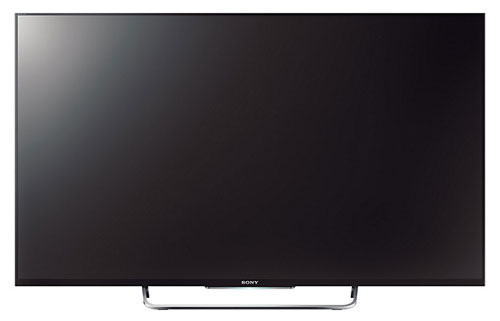
The Sony KDL50W829B is the 50-inch version within the new Bravia W8 range. Somewhat confusingly, the TV maker also had a W8 series on sale last year, but that uses an IPS LCD panel with passive 3D technology. 2014’s updated W8 features active-shutter glasses (ASG) 3D tech which suggests the presence of a VA-type panel that’s capable of deeper blacks than IPS. For the purpose of clarity, the 2014 model carries a moniker of W82-B (at least in the UK), whereas the 2013 version is also known as the W80-A.
Compared with the recently tested Bravia W705, the Sony W8 offers MotionFlow MCFI (motion-compensated frame interpolation) technology and obviously 3D capability. Are there any more differences beyond the spec sheet? Let’s find out.
We thought that the Sony W7 is almost an exact carbon copy of 2013’s Bravia W6. Well, the Sony W829 IS an exact carbon copy of the W705 cosmetically. The semi-glossy LCD screen is framed by an impressively slim matte black bezel, and sits on a silver low-profile stand which cannot be swivelled but can double as a bracket for wall-mounting.
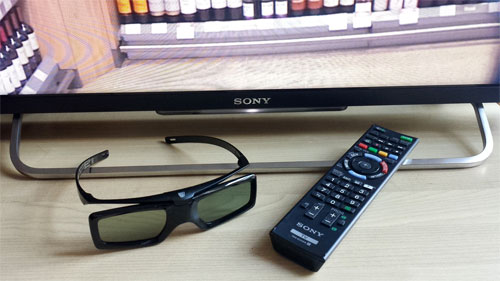
Whilst the KDL50W829 is undoubtedly a looker, what with the suitably convincing “picture suspended in thin air” effect granted by its slender bezel, some owners may be disappointed that Sony did not seek to differentiate the set from the step-down Bravia W7 series in terms of appearance, leaving any improvement under the hood. The TV comes with an external power supply which may be a plus or minus depending on your AV room arrangement. Build quality is acceptable, although the LCD panel does wobble back and forth slightly (more so than the smaller KDL42W705B) since its only secured to the stand by two screws.
Four HDMI ports are available on the Sony KDL-50W829B, of which HDMI 1 is MHL-capable, and HDMI 2 is ARC-enabled.
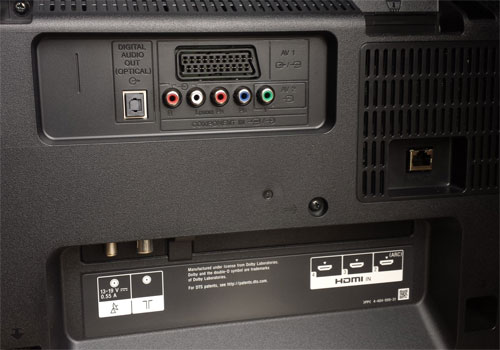 |
| Rear: 3 x HDMI, component, RGB Scart, aerial, satellite, LAN & audio out |
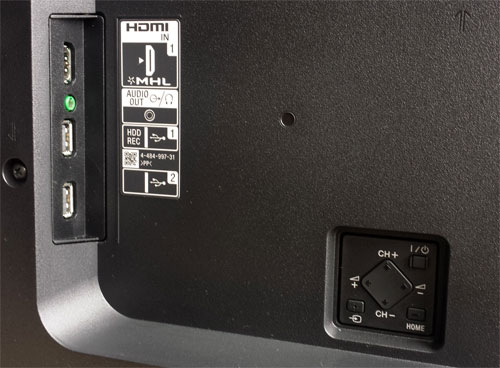 |
| Side: HDMI with MHL, 2 x USB, control buttons |
Every time our 50in W829 review unit was powered on from cold standby, it would take at least 30 seconds for certain remote button presses (for example summoning the home menu or switching input sources) to work as intended – the screen would instead return a “Please Wait” message. Once you get beyond this initialisation phase though, things do speed up.
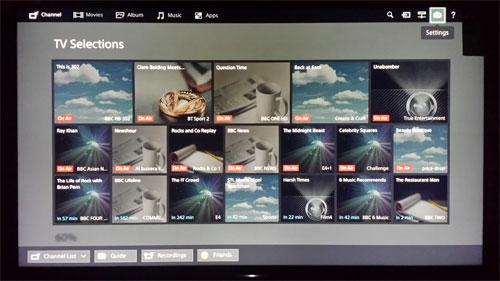
Last year’s revamped graphical user interface (which we actually quite liked) certainly didn’t last long, because Sony has commissioned another redesign of its Bravia television home menu for 2014. Fortunately the picture settings submenu remains unchanged styling-wise, though it’s been marginalised to a small, easy-to-miss icon at the top right of the home screen. Of course, the [Option] key on the remote control provides direct access to the KDL-50W829’s picture-affecting controls, allowing you to bypass the home menu altogether.
As usual, the Sony LED TV features a number of top-level picture presets lumped under the [Scene Select] menu, and if that’s not confusing enough, each [Scene Select] preset offers two further [Picture Mode] sub-presets. The two most useful [Scene Select] presets are “Cinema” for watching movies in a manner as close as possible to video industry standards, and “Game” for, uhm, playing games with minimum lag and maximum responsiveness.
Note: Our Sony KDL50W829B review sample was calibrated using CalMAN 5, the industry-leading video calibration software.
We started off with [Scene Select] set to “Cinema” which, from our experience of testing and calibrating Sony flat-panel TVs over the years, should yield the most accurate image out of the box.
In [Cinema 1] mode with [Colour Temperature] left at its default setting of “Warm 2“, greys had too much green and too little blue component. The discrepancy got wider as the image became brighter.
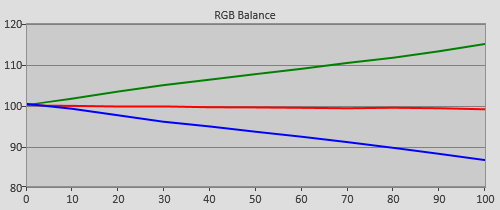 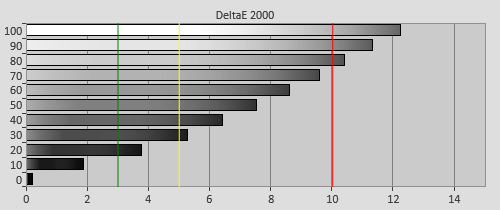 |
| Pre-calibration RGB tracking and delta errors (dEs) |
Sony’s onboard two-point [White Balance] controls came to our rescue. As with most Bravia flat-screen televisions, we only adjusted the gain controls (which in theory should have the most effect on brighter portions of the greyscale), since the bias (low-end) controls were too crude to be of use.
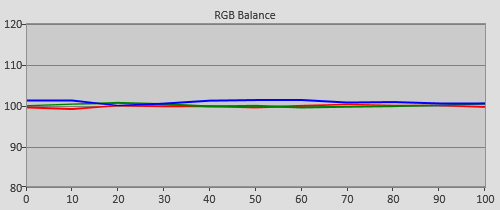 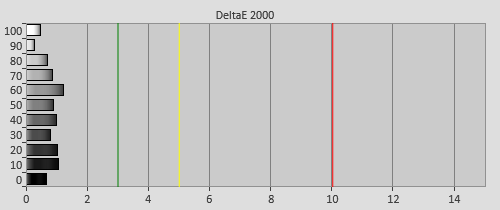 |
| Post-calibration RGB tracking and delta errors (dEs) |
The good news is, once we aligned the gain controls to D65K, everything fell into place. Delta errors dropped below 2 (the perceptible threshold for the human eye is generally accepted to be 3) across the entire luminance range, ensuring a neutral tint for high-def content displayed on screen.
We’ve praised Sony for embracing 2.4 gamma by default in its most accurate picture mode, and we’ll keep praising them until other manufacturers do the same. 2.4 is the reference EOTF (electro-optical transfer function) for studio mastering on a flat-panel HDTV in a dark room, recommended by no less an authority than the International Telecommunications Union (ITU), so there’s really no reason to ignore 2.4 gamma in favour of the more traditional 2.2 on a capable display in a dimly-lit viewing environment.
![Pre-calibrated Gamma tracking in [Cinema 1] mode](https://www.hdtvtest.co.uk/news/wp-content/uploads/2018/04/hdtv_Sony-KDL50W829B_pre-gamma.png) | ![Post-calibrated Gamma tracking in [Cinema 1] mode](https://www.hdtvtest.co.uk/news/wp-content/uploads/2018/04/hdtv_Sony-KDL50W829B_post-gamma.png) |
| Pre-calibration gamma tracking (2.34) | Post-calibration gamma tracking (2.35) |
On our KDL50W829 sample, the default [Gamma] setting of “-2” in [Cinema 1] mode actually undershot 2.4 slightly, coming in at around 2.35 which is more than acceptable. Gamma tracking was largely linear, contributing to a satisfyingly rich image with realistic total transition from black to white, save for a mild brightening of shadow detail which some users actually prefer.
Our Sony 50W8 unit exhibited a shrunken colour gamut which was even smaller (albeit only marginally) than that found on the 42W7. We could expand the gamut by bumping up [Colour] or engaging [Live Colour], but unfortunately either would also throw off colour decoding, as well as introduce inaccuracies into the sub-100% saturation tracking points.
![Post-calibration colour saturation tracking in [Cinema 1] mode](https://www.hdtvtest.co.uk/news/wp-content/uploads/2018/04/hdtv_Sony-KDL50W829B_post-strack.jpg) |
| Post-calibration colour saturation tracking |
In the end, [Live Colour] “Off” remained the most accurate setting, giving the least delta errors (dEs) when all our measured colour points were taken into account. However, the more saturated reds and blues would still look a touch muted in real-life viewing.
![Post-calibration colour errors in [Cinema 1] mode](https://www.hdtvtest.co.uk/news/wp-content/uploads/2018/04/hdtv_Sony-KDL50W829B_post-strack-de.png) |
| Post-calibration colour errors (<3 not appreciable to the eye) |
| Dead pixels | None |
| Screen uniformity | Very good for an edge LED TV |
| Overscanning on HDMI | 0% if [Screen Format] “Full” & [Display Area] “Full Pixel“ |
| Blacker than black | Passed |
| Calibrated black level (black screen) | LEDs dim down to 0.011 cd/m2 |
| Calibrated black level (ANSI checkerboard) | 0.042 cd/m2 |
| Black level retention | Auto-dimming with full black screen |
| Primary chromaticity | Undersaturated red and blue primary |
| Scaling | Very good |
| Video mode deinterlacing | Decent |
| Film mode deinterlacing | Passed 3:2 cadence over 480i |
| Viewing angle | Good for VA LCD panel |
| Motion resolution | 600 to 1080 with [Motionflow] engaged; 300, off |
| Digital noise reduction | Optional; effective when engaged |
| Sharpness | Defeatable edge enhancement |
| Luma/Chroma bandwidth (2D Blu-ray) | Full luma; chroma horizontally blurred except in [Game] & [Graphics] modes |
| 1080p/24 capability | No judder in 2D or 3D with [Motionflow] “Off“ |
| Input lag (high-speed camera) | 8ms compared to lag-free CRT in [Game] mode |
| Leo Bodnar input lag tester | 22ms in [Game] mode |
| Full 4:4:4 reproduction (PC) | Yes, in [Game] and [Graphics] modes |
| Default [Standard] mode | 27 watts* |
| Calibrated [Cinema 1] mode | 46 watts |
| Standby | <1 watt |
*Note: [Light Sensor] was engaged by default out of the box, which explains why energy usage was lower prior to calibration than after.
By sheer coincidence or amazing consistency, the AUO VA-type LCD panel implemented on the Sony KDL-50W829B returned the EXACT same black level as that measured on the 42in Bravia W705. Once we pegged peak white luminance to 120 cd/m2, native black level on the television came in at 0.042 cd/m2 on both a 4×4 ANSI checkerboard pattern and full-field black with auto-dimming defeated via a pause icon from our Blu-ray player. Otherwise, sending a full-screen video black signal to the W82B would cause the LED backlight to dim down automatically after a few seconds, lowering the measured black level to 0.011 cd/m2.
For readers who are not familiar with these figures, they amount to deep blacks by LED LCD standards. Contrary to what the manual states, there’s no [LED Dynamic Control] option in the user menu, so the KDL-50W829 is an edge LED TV that’s not equipped with pseudo-local dimming.
Our review unit exhibited fantastic backlight consistency once calibrated, without any light pooling, clouding or corner bleed in sight – a remarkable achievement on such a (relatively) large screen. Due to the way LEDs mounted along the edges are asked to illuminate the whole LCD screen, a mild dirty screen effect (DSE) was noticeable during panning shots across a uniformly toned background (think football field), but this is what we’ve come to expect from super-slim edge LED TVs, and is nothing we’d throw up our arms about.
This is one area where the Sony Bravia W82 trumps over the step-down W7 model, offering motion-compensated frame interpolation (MCFI) and black frame insertion (BFI) in various permutation and intensity through the supplied [Motionflow] control. Let’s go through the options one by one:
A quick paragraph on [Motionflow] “Impulse“, whose black frame insertion algorithm we found to be less aggressive and more user-friendly than the [LED Motion Mode] implemented on the lower-end W705 series. The KDL50W829’s [Impulse] mode evinced less flicker and double image ghosting than the KDL42W705’s [LED Motion Mode], and we managed to extract a higher light output of 49 cd/m2 with [Backlight] and [Contrast] cranked up to “Max“. Sure, it’s still quite dim, but it’s usable for viewers who crave the clearest/ sharpest motion from an LCD.
We discovered no new surprises with the X-Reality PRO engine on the Sony KDL50W829B which performed very similarly to other Bravia LED televisions in our array of video processing tests. Upconversion of standard-definition content was crisp with full detail capture and only very minor ringing, although [Reality Creation], if enabled, introduced the occasional flickering in busier areas on screen. Video-based material displayed with more jaggies than Panasonic, Samsung and LG HDTVs, which has always been the case for years now though we don’t find many people complaining about it.
With [Film Mode] set to “Auto“, the Sony W829B had no problem detecting and processing 3:2 cadence over 480i, but frequently lost the lock on 2:2 over 576i which is the more prevalent format for us in the United Kingdom and Europe. In other words, you may see jagged edges, line twitter or a softened image when watching film-based SD programmes through the inbuilt Freeview or satellite tuner. If you have a competent external set-top box, send a progressive signal to the TV for the best quality.
The KDL-50W829 features active 3D display technology, and ships with two pairs of active-shutter 3D glasses included in the box. Unlike most active 3-D LED TVs, the W82-B doesn’t deliver full HD 3D resolution, as revealed by our own custom 3D resolution test chart:
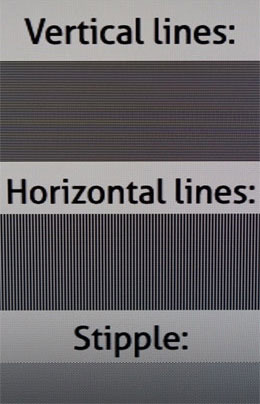 | 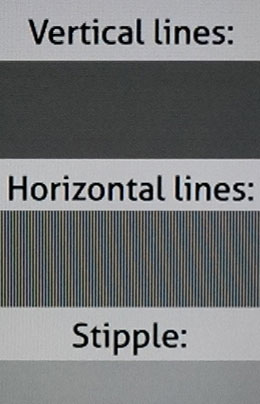 |
| Full HD 3D | Reduced vertical resolution on Sony W829 |
As you can see from the photo (cropped, unedited, unscaled) on the right which was taken from our Sony KDL-50W829B sample, the horizontal alternating black and white single-pixel lines (and even the diagonal “stipple” pattern) merge into one solid grey smudge, indicating a loss in vertical resolution. In real-world extra-dimensional viewing, this translates into a softer picture and visible jaggedness not unlike a passive 3D TV. Yet you do not even get to enjoy the lower crosstalk and flicker-free tri-dimensional images provided by passive 3D televisions. It’s just as well that Sony did not use the term “Full HD 3D” in its marketing literature, and not many people care about 3D anymore.
But if you are one of the select few who still care about the third dimension, the default [Motionflow] setting of “Standard” will cause 50Hz and 24Hz three-dimensional material to stutter on screen, since it forces the 3DTV to refresh at 60Hz. For a judder-free experience when viewing 50Hz (for example Sky 3D) or 24Hz (e.g. 3D Blu-ray) content, turn off [Motionflow].
When we sampled some high-quality 3D Blu-rays on the 50W82-B, we noticed a not insignificant amount of low-tone crosstalk and posterization which we failed to attenuate/ eradicate despite experimenting with all the options in the [3D Settings] submenu, suggesting insufficient bit depth allocation for 3-D. Put another way, the Sony KDL-50W829 is first and foremost a 2D display, with 3D slapped on as an afterthought.
True to form, the Bravia W829 is a fabulous gaming display. Our Leo Bodnar input lag tester returned a figure of 22ms once the TV was switched to [Game] mode, which will surely rank among the fastest in 2014. Setting [Motionflow] to “Impulse” added a mere 8ms (half a frame), bringing the number up to 30ms. [Cinema] mode was unplayable, with an input lag measurement of 92ms.
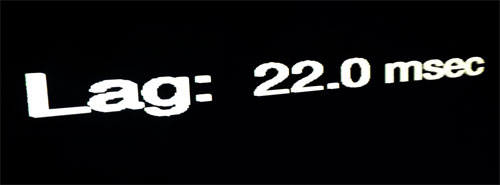
Like most Sony Bravias these days, [Game] mode on the KDL50W829 passed 4:4:4 chroma, as did [Graphics] mode, ensuring that even the tiniest colour data from relevant sources make it to screen.
This year’s Sony W8 is a different beast to last year’s Bravia W8, owing to a change in underlying LCD panel from IPS to VA which delivers much deeper blacks, resulting in a punchier and more alluring picture. Add accurate greyscale and 2.4 gamma to the mix, and the KDL50W829B is capable of highly filmic images, with the only slight shortcoming (as far as 2D is concerned) being undersaturated red and blue.
For many (especially gamers with an eye on input lag), the choice will be between the W829 and the step-down W705 series. On paper, the former offers 3D capability and higher motion resolution over the latter, but in reality, we found the KDL-50W829’s extra-dimensional viewing experience to be subpar because of reduced vertical resolution and inadequate bit depth. So in effect, you’re paying extra only for the motion-enhancing technologies which, to be fair, worked reasonably well on our W829B review unit. Decisions, decisions…
We would have penalised the Sony KDL-50W829B and graded it lower had the TV been priced higher, or if 3D is more than just a dying fad in most buyers’ eyes. But as things stand, it’s a 50″ HDTV, it’s good for watching movies and sports plus great for gaming, and it costs only £900 at launch. Following Panasonic’s plasma exit, we can’t imagine there being many better value-for-money proposition at this screen size for the year ahead.
Note: If you’re interested in buying this television, please support us by considering making your purchase from our advertising partner Crampton and Moore who will provide competitive prices and first-rate customer service. At the very least, please go ahead and like their Facebook page, many thanks!
